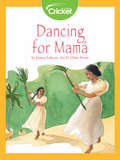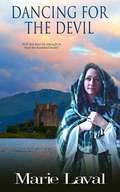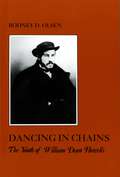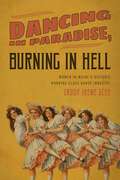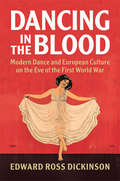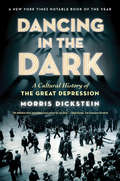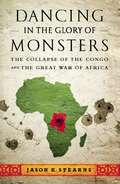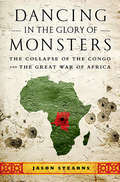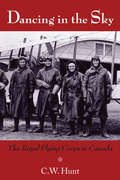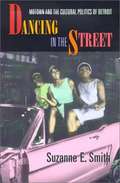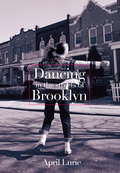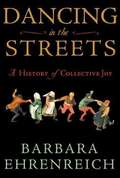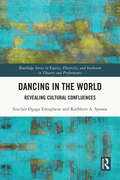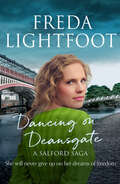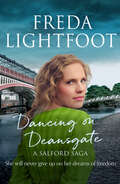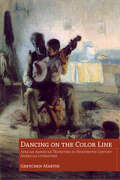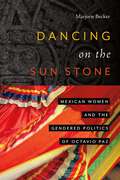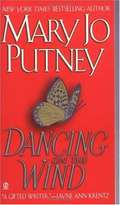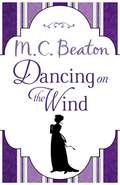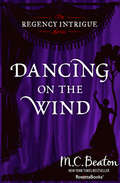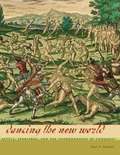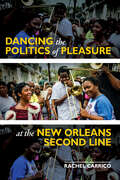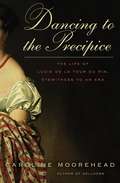- Table View
- List View
Dancing for Mamá
by Joanne LukensWithout her mother, will Margarita find the strength to dance for the approaching Festival de Las Flores?
Dancing for the Devil (Dancing For The Devil Ser. #2)
by Marie LavalCan her love heal his haunted heart? - Cape Wrath, Scotland, November 1847. Bruce McGunn is a man as brutal and unforgiving as his land. Discharged from the army, he is haunted by the spectres of his fallen comrades and convinced he is going mad. And he is running out of time to save his estate from the machinations of Cameron McRae, heir to the McGunn's ancestral enemies. When the clipper carrying McRae’s new bride is caught in a violent storm and docks at Wrath harbour, Bruce decides to revert to the old ways and hold the clipper and the woman to ransom. However, far from the spoilt heiress he expected, Rose is genuine, funny and vulnerable – a ray of sunshine in the long, harsh winter that has become his life. Rose is determined to escape Wrath and its proud master – the man she calls McGlum. Will she be reunited with Cameron McRae, the dazzlingly handsome aristocrat she married after a whirlwind romance in Algiers, or will she risk her heart and her honour to help Bruce discover the truth about his past and solve the brutal murders committed on his land?
Dancing in Chains: The Youth of William Dean Howells (The American Social Experience #15)
by Rodney D. Olsen"Dancing in Chains is far more than a sensitive biography (though it is surely that); it is also a model of psychologically informed social and cultural history. Olsen recognizes that psychic conflicts often play themselves out on a higher plane, that psychic and intellectual history are intertwined. He presents a wonderful nuanced picture of Howells."-Jackson Lears,Rutgers University In this insightful study of the childhood and youth of William Dean Howells, Dancing in Chains demonstrates how the turbulent social and cultural changes of the early nineteenth century shaped the young Howells's emotional and intellectual life. His early diaries, letters, poetry, fiction, and newspaper columns are used to illustrate Olsen's argument, which also in turn throws light on the dominant tensions in antebellum America. Accepting the emergent middle-class ethos of civilized morality, with its new conceptions of child rearing and gender spheres, Howells's parents urged him to achieve self-control and individual success while also teaching him to seek the good of others rather than his own glory. For Howells the conflicts coalesced at the time of his leaving home, an increasing common rite of passage for antebellum youth. Trying to affirm his sense of literary vocation, he tested his aspirations against the family's Swedenborgian religious convictions and the antislavery commitments of his village while experimenting with competing literary ideologies in the process of meeting the demands of the new mass reading audience. For Howells the resulting tensions eased toward the end of his youth but reappeared in his more mature works of fiction and social criticism in later years. Portraying the ordeal of coming of age during a momentous period of American history, Dancing in Chains is a fascinating study with a broad appeal to general readers as well as scholars.
Dancing in Paradise, Burning in Hell: Women in Maine's Historic Working Class Dance Industry
by Trudy Irene SceeAn often overlooked segment of Maine (and American) history is the story of women in the working class dance industries. Generally looked upon with a gasp of shock, burlesque and vaudeville dancing, and later taxi dancing and marathon dancing, were often the only way for women to survive (In taxi dancing, men paid women by the dance; while marathon dancing was a contest and women tried to outlast each other on the dance floor.) In turn-of-the-20th-century Maine, this new form of dancing was taking off, as it was elsewhere in the country. Historian Trudy Irene Scee explores the dance industries of Maine, how they were effected by national events, and how events in Maine effected national trends. She explores the difficulties women faced at that time and how they turned to new forms of entertainment to make money and pay for food and shelter. The focus of the book centers on the 1910s through the 1970s, but extends back into the 1800s, largely exploring the dance halls of the nineteenth century (be they saloons with hurdy-gurdy girls and the like, or dance halls with women performing the early forms of taxi- and belly dancing), and includes a chapter on belly dancing and other forms of dance entertainment in Maine in the 1980s to early 2000s. The newest form of dance—striptease dancing—is not be examined specifically, but is discussed as it pertains to the other dance forms. The book forms a unique look at one segment of Maine history and is a terrific addition to the literature on women&’s issues.
Dancing in the Blood: Modern Dance and European Culture on the Eve of the First World War
by Dickinson Edward RossThis is a remarkable account of the revolutionary impact of modern dance on European cultural life in the early twentieth century. Edward Ross Dickinson uncovers modern dance's place in the emerging 'mass' culture of the modern metropolis, sufficiently ubiquitous and high-profile to spark media storms, parliamentary debates, and exasperated denunciations even from progressive art critics. He shows how modern dance spoke in multiple registers - as religious and as scientific; as redemptively chaste and scandalously sensual; as elitist and popular. He reveals the connections between modern dance and changing gender relations and family dynamics, imperialism, racism, and cultural exchanges with the wider non-European world, and new conceptions of selfhood. Ultimately the book finds in these complex and often contradictory connections a new way of understanding the power of modernism and modernity and their capacity to revolutionize and transform the modern world in the momentous, creative, violent middle decades of the twentieth century.
Dancing in the Dark: A Cultural History of the Great Depression
by Morris DicksteinFinalist for the 2009 National Book Critics Circle Award in Criticism: from Agee to Astaire, Steinbeck to Ellington, the creative energies of the Depression against a backdrop of poverty and economic disaster. Only yesterday the Great Depression seemed like a bad memory, receding into the hazy distance with little relevance to our own flush times. Economists assured us that the calamities that befell our grandparents could not happen again, yet the recent economic meltdown has once again riveted the world's attention on the 1930s. Now, in this timely and long-awaited cultural history, Morris Dickstein, whom Norman Mailer called "one of our best and most distinguished critics of American literature," explores the anxiety and hope, the despair and surprising optimism of a traumatized nation. Dickstein's fascination springs from his own childhood, from a father who feared a pink slip every Friday and from his own love of the more exuberant side of the era: zany screwball comedies, witty musicals, and the lubricious choreography of Busby Berkeley. Whether analyzing the influence of film, design, literature, theater, or music, Dickstein lyrically demonstrates how the arts were then so integral to the fabric of American society. While any lover of American literature knows Fitzgerald and Steinbeck, Dickstein also reclaims the lives of other novelists whose work offers enduring insights. Nathanael West saw Los Angeles as a vast dream dump, a Sargasso Sea of tawdry longing that exposed the pinched and disappointed lives of ordinary people, while Erskine Caldwell, his books Tobacco Road and God's Little Acre festooned with lurid covers, provided the most graphic portrayal of rural destitution in the 1930s. Dickstein also immerses us in the visions of Zora Neale Hurston and Henry Roth, only later recognized for their literary masterpieces. Just as Dickstein radically transforms our understanding of Depression literature, he explodes the prevailing myths that 1930s musicals and movies were merely escapist. Whether describing the undertone of sadness that lurks just below the surface of Cole Porter's bubbly world or stressing the darker side of Capra's wildly popular films, he shows how they delivered a catharsis of pain and an evangel of hope. Dickstein suggests that the tragic and comic worlds of Broadway and Hollywood preserved a radiance and energy that became a bastion against social suffering. Dancing in the Dark describes how FDR's administration recognized the critical role that the arts could play in enabling "the helpless to become hopeful, the victims to become agents." Along with the WPA, the photography unit of the FSA represented a historic partnership between government and art, and the photographers, among them Walker Evans and Dorothea Lange, created the defining look of the period. The symbolic end to this cultural flowering came finally with the New York World's Fair of 1939-40, a collective event that presented a vision of the future as a utopia of streamlined modernity and, at long last, consumer abundance. Retrieving the stories of an entire generation of performers and writers, Dancing in the Dark shows how a rich, panoramic culture both exposed and helped alleviate the national trauma. This luminous work is a monumental study of one of America's most remarkable artistic periods.
Dancing in the Glory of Monsters
by Jason StearnsAt the heart of Africa is Congo, a country the size of Western Europe, bordering nine other nations, that since 1996 has been wracked by a brutal and unstaunchable war in which millions have died. And yet, despite its epic proportions, it has received little sustained media attention. In this deeply reported book, Jason Stearns vividly tells the story of this misunderstood conflict through the experiences of those who engineered and perpetrated it. He depicts village pastors who survived massacres, the child soldier assassin of President Kabila, a female Hutu activist who relives the hunting and methodical extermination of fellow refugees, and key architects of the war that became as great a disaster as--and was a direct consequence of--the genocide in neighboring Rwanda. Through their stories, he tries to understand why such mass violence made sense, and why stability has been so elusive. Through their voices, and an astonishing wealth of knowledge and research, Stearns chronicles the political, social, and moral decay of the Congolese State.
Dancing in the Glory of Monsters
by Jason StearnsAt the heart of Africa is Congo, a country the size of Western Europe, bordering nine other nations, that since 1996 has been wracked by a brutal and unstaunchable war in which millions have died. And yet, despite its epic proportions, it has received little sustained media attention. In this deeply reported book, Jason Stearns vividly tells the story of this misunderstood conflict through the experiences of those who engineered and perpetrated it. He depicts village pastors who survived massacres, the child soldier assassin of President Kabila, a female Hutu activist who relives the hunting and methodical extermination of fellow refugees, and key architects of the war that became as great a disaster as--and was a direct consequence of--the genocide in neighboring Rwanda. Through their stories, he tries to understand why such mass violence made sense, and why stability has been so elusive. Through their voices, and an astonishing wealth of knowledge and research, Stearns chronicles the political, social, and moral decay of the Congolese State.
Dancing in the Glory of Monsters: The Collapse of the Congo and the Great War of Africa
by Jason K. StearnsA "meticulously researched and comprehensive" (Financial Times) history of the devastating war in the heart of Africa's Congo, with first-hand accounts of the continent's worst conflict in modern times. At the heart of Africa is the Congo, a country the size of Western Europe, bordering nine other nations, that since 1996 has been wracked by a brutal war in which millions have died. In Dancing in the Glory of Monsters, renowned political activist and researcher Jason K. Stearns has written a compelling and deeply-reported narrative of how Congo became a failed state that collapsed into a war of retaliatory massacres. Stearns brilliantly describes the key perpetrators, many of whom he met personally, and highlights the nature of the political system that brought these people to power, as well as the moral decisions with which the war confronted them. Now updated with a new introduction, Dancing in the Glory of Monsters tells the full story of Africa's Great War.
Dancing in the Sky: The Royal Flying Corps in Canada
by C. W. HuntDancing in the Sky is the first complete telling of the First World War fighter pilot training initiative established by the British in response to the terrible losses occurring in the skies over Europe in 1916. This program, up and running in under six months despite enormous obstacles, launched Canada into the age of flight ahead of the United States. The results enabled the Allies to regain control of the skies and eventually win the war, but at a terrible price. Flying was in its infancy and pilot training primitive. This is the story of the talented and courageous men and women who made the training program a success, complete with the romance, tragedy, humour, and pathos that accompany an account of such heroic proportions. A valuable addition to Canada’s military history, this book will appeal to all who enjoy an exceptional adventure story embedded in Canada’s past.
Dancing in the Street: Motown and the Cultural Politics of Detroit
by Suzanne E. SmithDetroit in the 1960s was a city with a pulse: people were marching in step with Martin Luther King, Jr., dancing in the street with Martha and the Vandellas, and facing off with city police. Through it all, Motown provided the beat. This book tells the story of Motown--as both musical style and entrepreneurial phenomenon--and of its intrinsic relationship to the politics and culture of Motor Town, USA. <p><p>As Suzanne Smith traces the evolution of Motown from a small record company firmly rooted in Detroit's black community to an international music industry giant, she gives us a clear look at cultural politics at the grassroots level. Here we see Motown's music not as the mere soundtrack for its historical moment but as an active agent in the politics of the time. In this story, Motown Records had a distinct role to play in the city's black community as that community articulated and promoted its own social, cultural, and political agendas. Smith shows how these local agendas, which reflected the unique concerns of African Americans living in the urban North, both responded to and reconfigured the national civil rights campaign. <p><p>Against a background of events on the national scene--featuring Martin Luther King, Jr., Langston Hughes, Nat King Cole, and Malcolm X--Dancing in the Street presents a vivid picture of the civil rights movement in Detroit, with Motown at its heart. This is a lively and vital history. It's peopled with a host of major and minor figures in black politics, culture, and the arts, and full of the passions of a momentous era. It offers a critical new perspective on the role of popular culture in the process of political change.
Dancing in the Streets of Brooklyn
by April LurieFor thirteen-year-old Judy Strand, summers in Bay Ridge, Brooklyn, bustle with games of stickball played in the street, fun-filled outings to neighboring Coney Island, and her family’s yearly trip to the Catskill Mountains. But in July 1944, Judy’s carefree days and her innocence are shaken by a discovery: The man she’s always called Pa isn’t her real father. Even more shocking, Judy learns that the father she doesn’t remember was an alcoholic who abandoned his family. That’s why Judy’s mother emigrated to America from Norway. Now Judy feels jumbled inside: She’s angry at her mother for keeping the truth from her–and she’s suddenly awkward around Pa. Nothing her parents say soothes the hurt. At first, even the attentions of Jacob Jacobsen don’t make her feel any better. Judy likes Jacob; it’s just that his dad’s drinking binges hit too close to home. Ashamed, Judy doesn’t want anyone to find out her secret. But as misfortune befalls Jacob, Judy’s close friends, and her own family, Judy rallies to their side, and in the process recognizes that growing up encompasses forgiveness–of others and of herself.
Dancing in the Streets: A History of Collective Joy
by Barbara EhrenreichFrom the bestselling social commentator and cultural historian, a fascinating exploration of one of humanity's oldest traditions: the celebration of communal joy. In the acclaimed Blood Rites, Barbara Ehrenreich delved into the origins of our species' attraction to war. Here, she explores the opposite impulse, one that has been so effectively suppressed that we lack even a term for it: the desire for collective joy, historically expressed in ecstatic revels of feasting, costuming, and dancing. Ehrenreich uncovers the origins of communal celebration in human biology and culture. Although sixteenth-century Europeans viewed mass festivities as foreign and "savage," Ehrenreich shows that they were indigenous to the West, from the ancient Greeks' worship of Dionysus to the medieval practice of Christianity as a "danced religion." Ultimately, church officials drove the festivities into the streets, the prelude to widespread reformation: Protestants criminalized carnival, Wahhabist Muslims battled ecstatic Sufism, European colonizers wiped out native dance rites. The elites' fear that such gatherings would undermine social hierarchies was justified: the festive tradition inspired French revolutionary crowds and uprisings from the Caribbean to the American plains. Yet outbreaks of group revelry persist, as Ehrenreich shows, pointing to the 1960s rock-and-roll rebellion and the more recent "carnivalization" of sports. Original, exhilarating, and deeply optimistic,Dancing in the Streets concludes that we are innately social beings, impelled to share our joy and therefore able to envision, even create, a more peaceable future.
Dancing in the World: Revealing Cultural Confluences (Routledge Series in Equity, Diversity, and Inclusion in Theatre and Performance)
by Sinclair Ogaga Emoghene Kathleen A. SpanosHow can we create more inclusive spaces in the field of dance? This book presents a framework for dance practitioners and researchers working in diverse dance cultures to navigate academia and the professional dance field. The framework is based on the idea of "cultural confluences," conjuring up an image of bodies of water meeting and flowing into and past one another, migrating through what they refer to as the mainstream and non-mainstream. These streams are fluid categories that are associated with power, privilege, and the ability (or inability) to absorb other cultural forms in shared dance spaces. In reflective interludes and dialogues, Emoghene and Spanos consider the effects of migration on their own individual experiences in dance to understand what it means to carry culture through the body in various spaces. Through an analysis of language, aesthetic values, spaces, creative processes, and archival research practices, the book offers a collaborative model for communicating the value that marginalized dance communities bring to the field. This book will be of great interest to students, scholars, and arts administrators in dance.
Dancing on Deansgate (A Salford Saga)
by Freda LightfootWhen World War II brings danger to Manchester, a young woman sent to stay with her criminal uncle must find courage in this saga. Jess Delaney has always longed for independence. But when the Blitz reaches Manchester, she is locked in the cellar by her feckless mother, Lizzie. As bombs rain down from a sky turned blood red with flame, Jess waits for Lizzie to return. But fortunes are fickle, and soon Jess finds herself packed off to live with her tyrant Uncle Bernie, a bullying black marketeer. Though he treats her like a servant, she seeks refuge in the Sally Army and her natural musical talent offers both an escape route and the chance for love. But Uncle Bernie never forgives his niece for refusing to join his illegal schemes and threatens to deprive Jess of her hard-won freedom once and for all. This is a sweeping saga of hope and resilience perfect for fans of Kitty Neale and Rosie Goodwin.
Dancing on Deansgate (Salford Saga)
by Freda LightfootWhere there’s community, there’s courage…Jess Delaney has always longed for independence. But when the Blitz reaches Manchester, she is locked in the cellar by her feckless mother, Lizzie. As bombs rain down from a sky turned blood red with flame, Jess waits for Lizzie to return.But fortunes are fickle, and soon Jess finds herself packed off to live with her tyrant Uncle Bernie, a bullying black marketeer. Though he treats her like a servant, she seeks refuge in the Sally Army and her natural musical talent offers both an escape route and the chance for love.But Uncle Bernie never forgives his niece for refusing to join his illegal schemes and threatens to deprive Jess of her hard-won freedom once and for all.This is a sweeping saga of hope and resilience perfect for fans of Kitty Neale and Rosie Goodwin.Praise for Dancing on Deansgate‘A heart-wrenching story’ 5* Reader review‘It drew me in straight away’ 5* Reader review‘Another gem from a great writer’ 5* Reader review‘A compelling story of separation and hardship, and heartache overcome at last’ 5* Reader review
Dancing on Snowflakes
by Jane BonanderSusannah never meant to journey so far from Missouri, but she and her three-year-old son Corey wouldn't be safe until she found just the right place. Angel's Valley was a dusty town in the Sierra Nevada foothills where folks seemed friendly and not too nosy, a job as a dressmaker was open, and Susannah might get the fresh start for which she longed. And maybe she could forget her fears. ... When Nathan Wolfe rode into town. Five years before, when he'd had a pretty wife and a growing boy, he didn't see himself ever becoming a callous bounty hunter. Then he lost everything, including his ability to care. Now he'd been paid plenty to bring Susannah Walker back to Missouri. But something about this vulnerable yet determined young woman made him hesitate. He needed to get to know her. He wanted to hold her. And wary as she was, he might even convince her to trust him, a man sent to destroy her-or to show her that love could heal and set them both free.
Dancing on the Color Line: African American Tricksters in Nineteenth-Century American Literature
by Gretchen MartinThe extensive influence of the creative traditions derived from slave culture, particularly black folklore, in the work of nineteenth- and twentieth-century black authors, such as Ralph Ellison and Toni Morrison, has become a hallmark of African American scholarship. Yet similar inquiries regarding white authors adopting black aesthetic techniques have been largely overlooked. Gretchen Martin examines representative nineteenth-century works to explore the influence of black-authored (or narrated) works on well-known white-authored texts, particularly the impact of black oral culture evident by subversive trickster figures in John Pendleton Kennedy's Swallow Barn, Harriet Beecher Stowe's Uncle Tom's Cabin, Herman Melville's Benito Cereno, Joel Chandler Harris's short stories, as well as Mark Twain's Adventures of Huckleberry Finn and Pudd'nhead Wilson. As Martin indicates, such white authors show themselves to be savvy observers of the many trickster traditions and indeed a wide range of texts suggest stylistic and aesthetic influences representative of the artistry, subversive wisdom, and subtle humor in these black figures of ridicule, resistance, and repudiation. The black characters created by these white authors are often dismissed as little more than limited, demeaning stereotypes of the minstrel tradition, yet by teasing out important distinctions between the wisdom and humor signified by trickery rather than minstrelsy, Martin probes an overlooked aspect of the nineteenth-century American literary canon and reveals the extensive influence of black aesthetics on some of the most highly regarded work by white American authors.
Dancing on the Sun Stone: Mexican Women and the Gendered Politics of Octavio Paz
by Marjorie BeckerDancing on the Sun Stone is a uniquely transdisciplinary work that fuses modern Latin American history and literature to explore women&’s lives and gendered politics in Mexico. In this important work, scholar Marjorie Becker focuses on the complex Mexican women of rural Michoacán who performed an illicit revolutionary dance and places it in dialogue with Nobel Prize winner Octavio Paz&’s signature poem, &“Sun Stone&”—allowing a new gendered history to emerge.Through this dialogue, the women reveal intimate and intellectual complexities of Mexican women&’s gendered voices, their histories, and their intimate and public lives. The work further demonstrates the ways these women, in dialogue with Paz, transformed history itself. Becker&’s multigenre work reconstructs Mexican history through the temporal experiences of crucial Michoacán females, experiences that culminate in their complex revolutionary dance, which itself emerges as a transformative revolutionary language.
Dancing on the Wind (Fallen Angels #3)
by Mary Jo PutneyWith his unearthly beauty and diabolical cleverness, Lucien Fairchild, ninth Earl of Strathmore, has more than earned the nickname Lucifer. A tragic past has driven him to use his formidable talents to protect his country from secret enemies, and it is a job he does superlatively well...until he meets a mysterious woman whose skill at deception equals his own. By turns glamorous and subdued, reckless yet vulnerable, his enchanting adversary baffles his mind even as she captures his heart. A perilous mission has forced Kit Travers into a deadly game of ever-changing identities and needful lies, and a single misstep might cost her her life. But Lucien easily sees through her disguises. Unwilling to trust, yet unable to part, they join forces to search the dangerous underworld of London society-and discover that even two master deceivers cannot escape from passion's sensual web...or from an impossible love more precious than life itself. Book 3 of the Fallen Angel series. Sequel to The Controversial Countess and Thunder and Roses available by NLS.
Dancing on the Wind (Regency Season #8)
by M.C. BeatonI am going to die, she thought. It is sunny, and the whole of London is happy and joyous because I am going to die.' The great Marquess herself had come to enjoy the show.'Speech! Speech!' roared the crowd.Polly raised her hands and the crowd fell silent.'My lords, ladies, and gentlemen,' said Polly from the foot of the gallows. 'Why is it that such as I who am poor and have nothing should hang for a petty theft when such as she,' - here Polly paused and pointed straight toward the woman who'd captured her - 'Mrs. Blanchard, that abbess of Covent Garden, can commit murder on the souls of innocent country girls over and over again, and yet go free!'With those words Polly said her farewells and at last, 'I bid you good day, my friends. We shall meet again. For such as you who enjoy a spectacle such as this will surely roast in hell!
Dancing on the Wind (The Regency Intrigue Series #8)
by M. C. BeatonA Regency-era tale of romance and suspense, from the New York Times–bestselling author of the Agatha Raisin series. Beautiful young Polly grew up with Meg, the woman she knew as her aunt. But upon Meg&’s death, Polly discovers she was a foundling . . . and learns she is about to be cast out of her humble cottage. There&’s nothing to do but leave the village and set out for London—for Meg harbors deep suspicions about the elderly woman&’s demise. Only a day before she died, Meg had journeyed to Meresly Manor, and came back from the earl&’s estate with ugly bruises. Before she can untangle the dark secrets at the heart of this mystery, Polly will stand accused of murder and sentenced to hang—until a dashing nobleman offers to help her find the real killer . . . Previously published under the name Marion Chesney
Dancing the New World: Aztecs, Spaniards, and the Choreography of Conquest
by Paul A. ScolieriFrom Christopher Columbus to "first anthropologist" Friar Bernardino de Sahagún, fifteenth- and sixteenth-century explorers, conquistadors, clerics, scientists, and travelers wrote about the "Indian" dances they encountered throughout the New World. This was especially true of Spanish missionaries who intensively studied and documented native dances in an attempt to identify and eradicate the "idolatrous" behaviors of the Aztec, the largest indigenous empire in Mesoamerica at the time of its European discovery. Dancing the New World traces the transformation of the Aztec empire into a Spanish colony through written and visual representations of dance in colonial discourse-the vast constellation of chronicles, histories, letters, and travel books by Europeans in and about the New World. Scolieri analyzes how the chroniclers used the Indian dancing body to represent their own experiences of wonder and terror in the New World, as well as to justify, lament, and/or deny their role in its political, spiritual, and physical conquest. He also reveals that Spaniards and Aztecs shared an understanding that dance played an important role in the formation, maintenance, and representation of imperial power, and describes how Spaniards compelled Indians to perform dances that dramatized their own conquest, thereby transforming them into colonial subjects. Scolieri's pathfinding analysis of the vast colonial "dance archive" conclusively demonstrates that dance played a crucial role in one of the defining moments in modern history-the European colonization of the Americas.
Dancing the Politics of Pleasure at the New Orleans Second Line
by Rachel CarricoOn many Sundays, Black New Orleanians dance through city streets in Second Lines. These processions invite would-be spectators to join in, grooving to an ambulatory brass band for several hours. Though an increasingly popular attraction for tourists, parading provides the second liners themselves with a potent public expression of Black resistance. Rachel Carrico examines the parading bodies in motion as a form of negotiating and understanding power. Seeing pleasure as a bodily experience, Carrico reveals how second liners’ moves link joy and liberation, self and communal identities, play and dissent, and reclamations of place. As she shows, dancers’ choices allow them to access the pleasure of reclaiming self and city through motion and rhythm while expanding a sense of the possible in the present and for the future. In-depth and empathetic, Dancing the Politics of Pleasure at the New Orleans Second Line blends analysis with a chorus of Black voices to reveal an indelible facet of Black culture in the Crescent City.
Dancing to the Precipice
by Caroline MooreheadHer canvases were the court of Louis XVI and Marie Antoinette; the Great Terror; America at the time of Washington and Jefferson; Paris under the Directoire and then under Napoleon; Regency London; the battle of Waterloo; and, for the last years of her life, the Italian ducal courts. Like Saint-Simon at Versailles, Samuel Pepys during the Great Fire of London, or the Goncourt brothers in nineteenth-century France, Lucie Dillon--a daughter of French and British nobility known in France by her married name, Lucie de la Tour du Pin--was the chronicler of her age. La Rochefoucauld called her "a cultural jewel." The Sultan of the Ottoman Empire favored her for his dinner companion in Paris. Napoleon requested she attend Josephine. Her friends included Talleyrand, Madame de StaËl, Chateaubriand, Lafayette, and the Duke of Wellington, with whom she played as a child. She witnessed firsthand the demise of the French monarchy, the wave of Revolution and the Reign of Terror, and the precipitous rise and fall of Napoleon. She spent two years as an ÉmigrÉ in the newly independent United States (on a farm in Albany) but was also a familiar of Regency London. A shrewd, determined woman in a turbulent age of men, Lucie de la Tour du Pin watched, listened, reflected--and wrote it all down, mixing politics and court intrigue, social observation and the realities of everyday existence, to offer a fascinating chronicle of her era. In this compelling biography, Caroline Moorehead illuminates the extraordinary life and remarkable achievements of this strong, witty, elegant, opinionated, and dynamic woman who survived personal tragedy, including the loss of six children, and periods of extreme danger, exile, poverty, and illness. Meticulously researched, brilliantly written, and vastly entertaining, Moorehead's chronicle of Lucie's life is an incomparable social history of her times.
